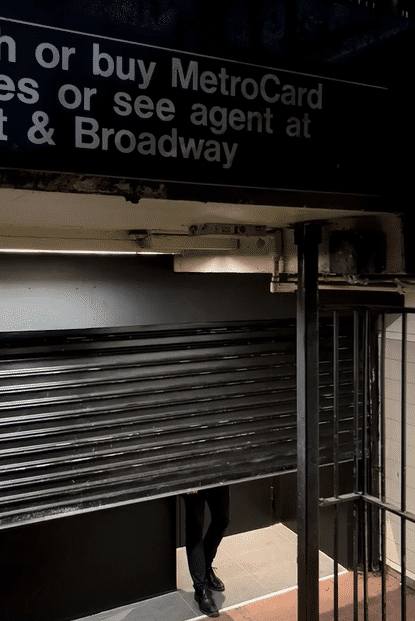If eating in the subway is this city’s last durable taboo, Noksu has its provocations built right in. The 13-seat dining counter, wrapped around a shockingly pristine kitchen, is housed in a former barbershop in the northeast entrance to the Herald Square B/D/F/M/N/Q/R/W station. To enter, you descend into its bowels like any commuter and, armed with a six-digit door code to ease your way, take a left where the crowd surges right. Inside, Noksu is all gray-veined marble and inky abstracts, a frictionless dreamland where the chairs push you in. “Sit all the way back,” a jacketed captain says, “and I’ll do the rest.”
During two nightly seatings, Noksu fills with takers for chef Dae Kim’s 12-course menu. Just 27, Kim has the piecey hair of a K-pop heartthrob and the technique of a hardened modernist. His plates are painstakingly arranged by tweezer: miniature gardens of edible flowers, gelatinized spheres, and weightless foams, often all at once. Even before the optional additions of Hokkaido uni or Italian white truffle, there is a risk of muchness: A finger bowl of oyster and snapper with cured roe and apple sorbet was positively hectic. More focused was a rye tartlet, crowned with tiny petals of hakurei turnip and blobs of preserved umeboshi plum concealing a filling of sweet, whisperingly saline crab innards, meant to be taken down in one bite.
Course after course arrives this way: tiny, intricate, built over days, disappeared within seconds. When Kim’s obsessive precision pays off, the results can be wonderful. A rare-cooked half-moon of trout, iced with a paste of trout-belly tartare, then glazed with ponzu–black-truffle gelée and served, for good measure, with a pricklingly tart yuzu hollandaise. A shingle of venison, plugged with a pistachio-flecked venison sausage, on a slick of liverish sauce. A squab, whose nut-brown body a cook has ladle-bathed in hot oil, appears on the plate as bronzed breast, taloned leg, and crisped hemisphere of skull. “You didn’t eat the head last time!” co-owner Bobby Kwak scolded me on my second visit. I thought I had—its eggy little wisp of brain was soft, experiential, maybe a little flavorless—but I’d missed the architecture. The whole thing is edible, to be picked up by the beak and crunched like a musky potato chip.
Do Noksu’s staff members see the humor in this urbanite’s ortolan? Ultimately, the restaurant is serving pigeon in a subway station. If they do, they are keeping mum. The nominal inspiration is the barbecued birds hanging in the window of the Chinatown restaurants that Kim—who moved to the U.S. from Seoul at 14—spent his teenage years going to, though his great innovation with the squab is a cardamom-scented, West African–inflected barbecue sauce, which I would buy by the bottle.




Clockwise from top-left: Opening for the evening, preparing squab. plating a crab tartlet, and diners with the plated squab. Photos: Hugo Yu.
Clockwise from top-left: Opening for the evening, preparing squab. plating a crab tartlet, and diners with the plated squab. Photos: Hugo Yu.
Your own enjoyment of Noksu will likely depend as much on your interest in micropyrotechnics as on your appetite: You are there to be wowed, having stumbled upon a secret to be savored, first privately and then, inevitably, publicly. During one of my meals, a pretty solo diner named Mai Pham was at the next seat, recording her every bite into a pair of oversize iPhones, one for video, one for audio, for her 3 million followers on YouTube. She looked a little uncertain when she got to the squab head.
Sealed off from the traffic of a normal restaurant, Noksu can feel — as can many tasting counters where dinner for two easily reaches $1,000 — a little airless and reverential. The privacy, the smallness, the total lack of windows: Noksu is like a luxury submarine set to a soundtrack of easy listening. “I know this much is truuue,” Spandau Ballet crooned as we spooned our caviar-flecked custard with scallop-y discs of surf clam. This is how the other half bunkers.
The subway is the ineffable seasoning of Noksu: its tantalizing spark of wrongness, luxury smashed up against municipal utility. You may wish it were a wrongness about which you knew less. Kwak ringleads meals chattily, but at $225 a head, it seems like bad manners to regale guests with stories of having to power-spray the restaurant’s entrance clean of a human extrusion he called “No. 3.”
Yet if you give yourself over to the theater of the experience, plenty of pleasure can be had. This is a rare and weird opportunity, long gestated. Kwak and his partners first secured the space (technically a part of the Martinique hotel at street level) in 2019, then had to wait out the worst of the pandemic. The otherworldliness of it is the point. You’re here for the spectacle, until you’re turned back out into the turnstiles. As they say in the subway — and you’re in the subway — it’s showtime.
See All
